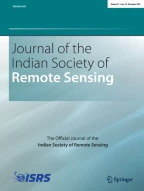Abstract
In this paper, a new noisy remote sensing image segmentation algorithm combined with wavelet shrinkage and graph cuts model is proposed. The entire process of noisy remote sensing image segmentation is composed of two steps. Firstly, the wavelet transform is used to extract information about sharp variations in the remote sensing images and the shrinkage function is applied to adapt the image features, and image noise is eliminated by utilizing the feature adaptive threshold method. Secondly, graph cuts based on active contour (GCBAC) model is applied to segment the de-noised image. Additionally, a new energy function which disregards the regularising parameter is proposed in the GCBAC model in order to avoid the edge and region balance problems, and the GCBAC model is used to extract the desired segmentation object by constructing a specified graph. Simulation results indicate that the proposed algorithm can effectively improve the quality of image segmentation and demonstrates improved robustness to noise.
Similar content being viewed by others
References
Boykov, Y., & Funka-Lea, G. (2006). Graph cuts and efficient N-D image segmentation. International Journal of Computer Vision, 70(2), 109–131.
Boykov, Y., & Kolmogorov, V. (2004). An experimental comparison of min-cut/max-flow algorithms for energy minimization in vision. IEEE Transactions on Pattern Analysis and Machine Intelligence, 26(9), 1124–1137.
Gupta, K. K., & Gupta, R. (2007). Feature adaptive wavelet shrinkage for image denoising (pp. 81–85). Chenai: IE- EE-ICSCN, MIT Campus, Anna University.
Juan, O., & Boykov, Y. (2006). Active graph cuts. Proceedings of the IEEE Computer Society Conference on Computer Vision and Pattern Recognition, 1, 1023–1029.
Tao, W. (2012). Iterative narrowband-based graph cuts optimization for geodesic active contours with region forces (GACWRF). IEEE Transactions on Image Processing, 21(1), 284–296.
Wang, L., Li, C., Sun, Q., & Kao, C. Y. (2009). Active contours driven by local and global intensity fitting energy with application to brain MR image segmentation. Computerized Medical Image and Graphics, 33(7), 520–531.
Xie, X., Wang, C., Zhang, A., & Meng, X. (2014). A robust level set method based on local statistical information for noisy image segmentation. Optik, 125(9), 2199–2204.
Xie, X., Zhang, A., & Wang, C. (2015). Local average fitting active contour model with thresholding for noisy image segmentation. Optik, 126(9–10), 1021–1026.
Xu, N., Ahuja, N., & Bansal, R. (2007). Object segmentation using graph cuts based active contours. Computer Vision and Image Understanding, 107(3), 210–224.
Yi, X., Hu, Y., Jia, Z., Wang, L., Yang, J., & Kasabov, N. (2014). An enhanced multiphase Chan-Vese model for the remote sensing image segmentation. Concurrency and Computation: Practice and Experience, 26(18), 2893–2906.
Zhang, K., Zhang, L., Song, H., & Zhou, W. (2010). Active contours with selective local or global segmentation: a new formulation and level set method. Image and Vision Computing, 28(4), 668–676.
Zhao, F., Jiao, L., Liu, H., & Gao, X. (2011). A novel fuzzy clustering algorithm with non local adaptive spatial constraint for image segmentation. Signal Processing, 9–1(4), 988–999.
Zheng, Q., Dong, E., & Cao, Z. (2012). Graph cuts based active contour model with selective local or global segmentation. Electronics Letters, 48(9), 490–491.
Acknowledgments
This work was supported in part by the International Cooperative Research and Personnel Training Projects of the Ministry of Education of the People’s Republic of China [Grant number DICE2014-2029].
Author information
Authors and Affiliations
Corresponding author
About this article
Cite this article
Li, L., Jia, Z., Yang, J. et al. Noisy Remote Sensing Image Segmentation with Wavelet Shrinkage and Graph Cuts. J Indian Soc Remote Sens 44, 995–1002 (2016). https://doi.org/10.1007/s12524-016-0561-x
Received:
Accepted:
Published:
Issue Date:
DOI: https://doi.org/10.1007/s12524-016-0561-x
